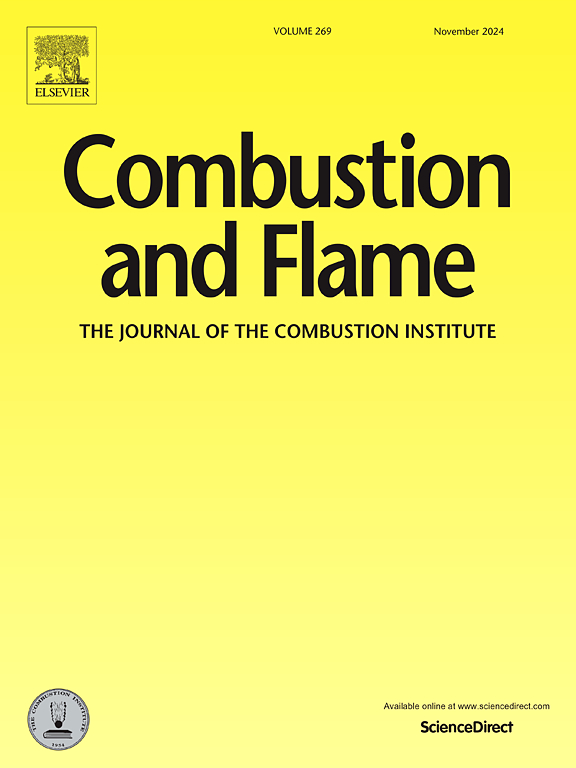Experimental and modeling study on the high-temperature ignition of ammonia/diethyl ketone
IF 5.8
2区 工程技术
Q2 ENERGY & FUELS
引用次数: 0
Abstract
The ignition delay times (IDTs) of NH3/diethyl ketone (DEK) mixtures at DEK blending ratios (XDEK) of 0.05, 0.1, and 0.5 were measured in a shock tube at equivalence ratios (φ) of 0.5, 1.0 and 2.0, pressures of 1.75 and 10 bar, and temperatures from 1200 to 1900 K. The addition of DEK with XDEK = 0.05 significantly improves the combustion performance of ammonia. A detailed DEK-NH3 model was proposed including the NH3 sub-model, the DEK sub-model, and the cross-reactions between hydrocarbon/oxygenated species and nitrogen-containing species. The model well predicts the IDTs of NH3/DEK mixtures measured in this study, and the IDTs of pure NH3 reported in the literature. The cross-reactions consist of the prompt NO and reburn reactions (reaction-class 1), the recombination reactions and the oxidation reactions of small amines (reaction-class 2), the H-atom abstraction reactions (reaction-class 3), and the disproportionation reactions (reaction-class 4). The comparison of the model predictions shows that the reaction-class 1 and 2 have negligible effects on the ignition. The reaction-class 3 slightly promotes the ignition and the reaction-class 4 significantly inhibits the ignition. The dependence of the effects of the cross-reactions on the blending ratio and pressure are discussed in detail. The NH3/DEK oxidation pathway is also analyzed.
氨/二乙基酮高温点火的实验与模拟研究
在激波管内,测定了NH3/二乙基酮(DEK)混合物在DEK掺合比(XDEK)分别为0.05、0.1和0.5时的点火延迟时间(IDTs),其等效比(φ)分别为0.5、1.0和2.0,压力分别为1.75和10 bar,温度为1200 ~ 1900 K。添加XDEK = 0.05的DEK可显著提高氨的燃烧性能。提出了一个详细的DEK-NH3模型,包括NH3子模型、DEK子模型以及含烃/含氧物种与含氮物种之间的交叉反应。该模型很好地预测了本研究中测量的NH3/DEK混合物的idt,以及文献中报道的纯NH3的idt。交叉反应包括:1级反应,再燃反应;2级反应,小胺的复合反应和氧化反应;3级反应,h原子抽离反应;4级反应。模型预测结果表明,1级反应和2级反应对着火的影响可以忽略不计。反应级3对着火有轻微促进作用,反应级4对着火有明显抑制作用。详细讨论了交叉反应对混合比和混合压力的影响。分析了NH3/DEK氧化途径。
本文章由计算机程序翻译,如有差异,请以英文原文为准。
求助全文
约1分钟内获得全文
求助全文
来源期刊

Combustion and Flame
工程技术-工程:化工
CiteScore
9.50
自引率
20.50%
发文量
631
审稿时长
3.8 months
期刊介绍:
The mission of the journal is to publish high quality work from experimental, theoretical, and computational investigations on the fundamentals of combustion phenomena and closely allied matters. While submissions in all pertinent areas are welcomed, past and recent focus of the journal has been on:
Development and validation of reaction kinetics, reduction of reaction mechanisms and modeling of combustion systems, including:
Conventional, alternative and surrogate fuels;
Pollutants;
Particulate and aerosol formation and abatement;
Heterogeneous processes.
Experimental, theoretical, and computational studies of laminar and turbulent combustion phenomena, including:
Premixed and non-premixed flames;
Ignition and extinction phenomena;
Flame propagation;
Flame structure;
Instabilities and swirl;
Flame spread;
Multi-phase reactants.
Advances in diagnostic and computational methods in combustion, including:
Measurement and simulation of scalar and vector properties;
Novel techniques;
State-of-the art applications.
Fundamental investigations of combustion technologies and systems, including:
Internal combustion engines;
Gas turbines;
Small- and large-scale stationary combustion and power generation;
Catalytic combustion;
Combustion synthesis;
Combustion under extreme conditions;
New concepts.
 求助内容:
求助内容: 应助结果提醒方式:
应助结果提醒方式:


